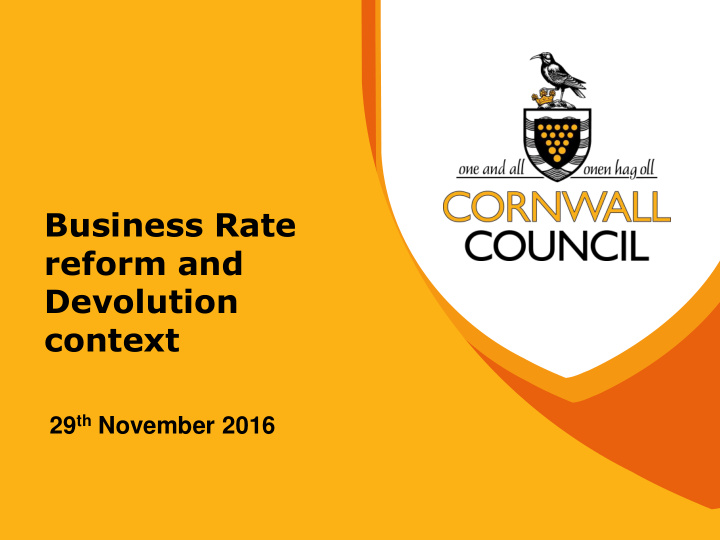



Business Rate reform and Devolution context 29 th November 2016
Broad reasoning for Government approach • The proposed changes are to make local authorities: • More financially independent and increase local accountability • Have an incentive to promote business growth • Design services for communities and citizens • Main thrust of proposal is Business Rates Retention
Business Rate Retention - Concerns • Business rates poor proxy for economic growth • Does not reflect SME’s, knowledge industry, rural economy, tourist economy, natural resources • Not for profit organisations – Charities and social enterprises – will not generate business rate income • Timing – localisation in challenging economic times • No link between business growth and tax • Sparsity and rural issues
Cornwall property market • Range and choice/age • Older buildings = heritage value, attractive for ICT/media • 40,000+ working ‘from home’ • Workspace crucial for growth journey • Retail & banking moving away from fixed property costs • ‘Different’ role for town centres • Cost factors: remediation of brownfield • Planning rules – ‘Housing first’
Business Rate Retention - Positives • Local influence over resource base – link between local growth and income • Link between LEP activity and council resource base • * Will also generate increase in secondary activity and supply chain • * Will also ultimately generate an increase in the council tax base linked to more workers
Devolution & other examples • No variance of multiplier • No geographic discretion • No sector discretion • Money to budget, not just economic development • France – turnover tax linked to GVA • Germany – property AND transfer tax • Cornwall – big footprint, small numbers of workers (Economic Strategy) • Re- set: Economies are ‘regional’ • Other fiscal devolution
What Cornwall needs • Incentivise home based businesses • Upgrade and refurbish businesses in areas of high demand • Encourage growth of renewable sector • TIF to support gap funding • Pressure on cultural sector/charging • Post Brexit confidence
Enterprise Zones (EZ) • EZ provided with: – Simplified planning rules – ‘Local Development Order’ – Super-fast broadband – £150m tax breaks for new businesses over 4 years – Business Rate holiday for first 5 years (new businesses only) • Business rate growth within EZ kept by the Local Enterprise Partnership for 25 years – can be used in whole LEP area and Council not disadvantaged • EZ Business Rates growth exempt from the levy and resets for a defined period
Local Plan context • Extant employment permissions • Only a third delivered 2010-15 to meet LP commitments (recession). • Would reach target in 2040s! • Intervention/support from Economic Development • 700,000sqm of workspace will generate growth. Infrastructure opportunities • But backloaded into the 2020s
Local Plan • Loss of 75,000 sm of employment space since 2010 • Increase of 100,000 sqm • Hit particular places • But, reconfiguration of how business is done • London hit means investment opportunities for Cornwall • Forecast 38,000 more jobs (perhaps only a quarter to a third on ‘land’)
Recommend
More recommend